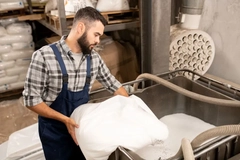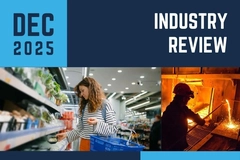The history of soup packaging: Pouches and cartons challenge classic tin cans with eco-convenience

30 Nov 2020 --- When we think of commercialized soup, the homologous Campbell’s tin can immediately comes to mind.
The iconic soup tin rose to international fame through Andy Warhol’s 32 Campbell’s Soup Cans print painting series from 1962, turning an everyday pantry shelf item into a revered work of art.
Since Campbell’s first canned beefsteak tomato soup launch in 1895, soup packaging has hit retailer shelves in a range of innovative packaging formats.
Stand-up flexible plastic pouches and paperboard cartons are the new supermarket norm, lowering product weight while maximizing brand marketing space and convenient use.
PackagingInsights digs into the evolution of soup packaging with Amcor, Huhtamaki and SIG to learn how they have come to identify and address generations’ ever-changing soup preferences.
Military-inspired pouch innovations
The story of switching out tinned soup for flexible solutions begins in the 1970s with dehydrated products.
“Military needs led the initial development of a lighter yet long shelf life packaging for ready-to-eat foods in a cost-efficient way,” explains Manfred Marz, F&B general manager of flexible packaging Europe at Huhtamaki.
 Huhtamaki offered flexible pouches in the 1970s for longer food shelf life military demands.“The Huhtamaki Ronsberg facility, at that time named 4P and part of the Unilever group, was among the first to produce those. Due to its convenience, lower weight and improved shelf life, this packaging type gained more and more popularity in a short period of time.”
Huhtamaki offered flexible pouches in the 1970s for longer food shelf life military demands.“The Huhtamaki Ronsberg facility, at that time named 4P and part of the Unilever group, was among the first to produce those. Due to its convenience, lower weight and improved shelf life, this packaging type gained more and more popularity in a short period of time.”
The logical next step was introducing the same in wet soups, which consequently started to appear in flexible packaging in the 1990s.
“As Huhtamaki already had experience in sterilizable packaging materials with pet food, it was easy to enter that market too,” Marz explains.
Over the years, Huhtamaki has “constantly improved” the puncture resistance, sealing properties and barrier structures of its flexible pouches to address consumer demand for more convenient delivery formats.
The company has developed wet and dry soup pouches that are light-weight with easy tear-off openings. Flexible packaging has also become popular because their sterilization process is faster than cans, adds Marz.
Can openers démodé
Traditional metal tins often still require a can opener, which may be perceived as old-fashioned and unhandy.
According to Amcor’s latest survey on soup packaging, metal tin cans are indeed falling out of favor. Of over 1,500 survey participants, 75 percent said they would consider buying more canned food if cans were easier to open.
“Interestingly, easy-opening cans had higher appeal with shoppers ages 18-34 with 78 percent saying they would buy more cans if they were easier to open,” Geoffrey Gendebien, marketing manager at Amcor Flexibles EMEA, points out.
Amcor’s AluFix line aims to attract younger consumers with easy opening peel-off-ends.Meanwhile, only 63 percent agreed in the 55+ age category. To give nostalgic metal cans a modern appeal to younger consumers, Amcor developed its AluFix line with an easy peel-off aluminum lidding.
Lighter carbon footprint
Metal cans are still inherently at a disadvantage because of their heavy weight. Compared to metal cans, flexible pouches reduce carbon footprints with lighter transportation loads and more resource efficiency.
Therefore, Amcor also has a range of flexible pouches that provide brands with enhanced design opportunities, with options such as spouts for easy pouring, different shapes and sizes, and decorative and tactile graphic design effects.
Depending on which food is being packaged, brands can stand out in crowded supermarket aisles with clear windows that show the product inside to appeal to shoppers.
According to Innova Market Insights data, convenience-focused packaging formats such as heat-sealed packets and doy pouches are among the fastest-growing packaging formats. They have shown an average annual growth of 29 percent and 25 percent, respectively (CAGR, 2015-2019, Global).
Eco-halo on “dominant” paper cartons
The 21st century ushered in scrutiny of single-use packaging’s environmental impact. Consumers now want packaging to be eco-friendly and circular, but without compromising on convenience.
Recyclable paper materials as alternatives to plastic packaging are increasingly associated as being more circular, light-weight and renewable while still catering to convenience demands.
SIG’s combibloc cartons appeal to eco-conscious consumers who prefer paper-based packaging solutions.Norman Gierow, head of European marketing at SIG, notes how carton packs have become the “dominant packaging solution” for soups, challenging the established metal can.
SIG’s combibloc line of aseptic cartons boasts consumer-coveted environmental credentials like FSC certification, detailed on front-of-pack. The cartons’ box shapes also make for space-efficient transportation and easy-opening.
Post-pandemic predictions
Arriving at the present pandemic-stricken day, soup packaging is bound to remain relevant as soup sales surge.
Soups are well-known for being a nutritious and low-cost home remedy against the common cold and flu. Innova Market Insights data indicates one in four consumers is increasing their soup consumption, with health concerns specifically being the key driver.
The pack design has to reflect product contents. “Consumers tend to buy natural or natural-looking products,” Marz explains. “Huhtamaki reacts to those trends and offers material solutions that meet these requirements.”
Gendebien anticipates lockdown restrictions to continue well into 2021. While the initial quarantine phases encouraged global consumers to experiment with cooking more from home, Amcor is now noticing the toll of COVID-19 cooking fatigue.
“Consumers are seeking a balance between spending time cooking and fast-and-ready meals. Looking to 2021, ready-to-heat soups and sauces are likely to have high appeal both for their convenience and long shelf life,” he adds.
2021 e-commerce and hygiene demands
Consumers spending more time at home means e-commerce sales are up, necessitating durable product packaging.
“Packaging [needs to be] e-commerce-ready if they want to ride the wave of increased online spending. For liquid products traveling through the e-commerce supply chain, robust packaging is key to avoid leaks or burst packs,” notes Gendebien.
 Today’s soup packaging needs to be light-weight and easy to pour while still providing enough branding space (Credit: Amcor).Overall, COVID-19 has reminded people of food safety and the importance of hygiene – “something many of us had come to take for granted,” admits Marz.
Today’s soup packaging needs to be light-weight and easy to pour while still providing enough branding space (Credit: Amcor).Overall, COVID-19 has reminded people of food safety and the importance of hygiene – “something many of us had come to take for granted,” admits Marz.
“The role of packaging in protecting food and ensuring hygiene is now better understood – we still need to work on communicating the role of packaging in reducing food waste and thus protecting the environment, instead of being seen as waste.”
All roads lead to sustainability
In addition to health and hygiene, the novel coronavirus has evoked a greater commitment from consumers to purchase from responsible companies who are realizing how interconnected food and health industries are.
“COVID-19 highlights how crucial it is for companies to consider their impact. The pandemic has sparked an important conversation about how businesses can better support people, society and the environment,” says Gierow.
In the post-COVID-19 era, businesses will be “scrutinized more than ever,” he predicts, not only in what they produce but also in how they act.
“If a producer wants to offer more sustainable and responsible products, then packaging and the system behind it is a good place to start. Packaging is the first key touchpoint for consumers and influences the entire brand experience.”
By Anni Schleicher










